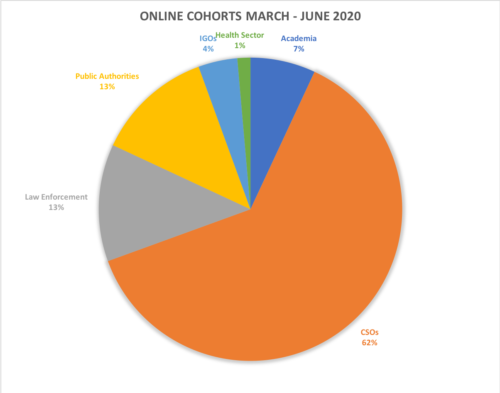Online learning during COVID-19
In March 2020 we suddenly woke up in a completely different world. The COVID-19 outbreak has changed our lives and led to the beginning of a period of great uncertainty. While this new global crisis has shaken our existence, we have also been gifted with more time for self-reflection and analysis.
by Melissa Sonnino
During the lockdown, when our routine of in-person meetings, travels and international conferences was indefinitely suspended, we felt the urgency to answer few fundamental questions about our work: how is our work meaningful? Are we useful? If so, how can we be most useful now?
Facing Facts is active in the field of capacity building, advocacy and research on hate crime and hate speech since 2011. Our e-learning platform, hosted by Moodle, offers a wide range of online courses and resources on the topic of hate crime which are regularly used by civil society organisations, law enforcement and public authorities. Back in March, like many others, we found ourselves wondering about the consequences of the pandemic on people and communities at risk of hate crimes. We wondered about the new challenges associated with the pandemic for those at the forefront of responding to hate crimes and victim support. Learners on our platform would have certainly come up with a whole new set of learning needs to which we should be ready to respond.
How did we go about designing a course to meet these challenges?
We assessed our resources and capacities in order to articulate a meaningful learning offer considering the circumstances. We could count on a unique set of flexible online learning tools on the subject of hate crime. We could also count on the availability of experienced tutors and their ability to quickly adapt to new learning challenges. A virtual space for peer learning and exchange was offered by our e-learning platform. Mostly, we could offer a neutral space and facilitation skills for participants to share their experiences and worries in a constructive manner.
We deemed all of the above enough to organise an online cohort on the subject of monitoring and responding to hate crimes in a time of global crisis. We didn’t promote the course pretending to have all the answers. Our intention was to provide a framework to explore the topic of hate crime in the situation we were all in.
When did we hold the courses and who signed up?
On March 25th we opened a call for participants to the new online course, which was oversubscribed in less than a week. We assigned places on a first come, first served basis. The course saw the participation of academia, civil society organisations (CSOs), law enforcement, public authorities and international organisations (IGOs) representatives. The high demand for the course convinced us to offer another cohort later in June.
The geographic diversity within the group of participants added another interesting element to our learning challenges, spanning North America, India, Nepal, Malaysia, Georgia and Europe.

As we can see from the chart above, out of a total of 110, the majority of participants were from a civil society organization background. The second largest group were law enforcement and other public authorities, followed by researchers and intergovernmental agency staff. This gave us a rich mix of experience and perspectives.
What did the courses cover?
The courses consisted of three modules offered over a span of four weeks. We didn’t want to assume advance knowledge of hate crime, so we focused on the basics. This included:
- understanding the hate crime concept and related international standards;
- identifying and monitoring the most common forms of hate crime and their impact on victims and communities
- using monitoring and quantitative data to advocate and secure improved safety, support and justice for victims and communities
- exploring what we know and can understand about the immediate and longer-term impact of the coronavirus on at-risk communities
The findings of the Facing all the Facts research were also integrated in the course activities, offering new insights into the area of cooperation and highlighting the importance of a multi-stakeholder approach, already reflected in the composition of the cohort’s participants. Resources and activities were adapted along the way in both cohorts, as participants’ learning needs emerged over time in the discussion forum and during the live tutorial sessions.
What kinds of questions and issues came up?
As is often the case when learning about hate crime, there was rich discussion about the concept of hate crime and a need to acknowledge that while academically it is a debated concept, practically speaking, there is a need for clear and consistent definitions and approaches, especially at the international level. Sessions on bias indicators[1] also produced rich discussion and debate. Common questions included: how many bias indicators are needed to record a hate crime? Is one more powerful than another? As is often the case when learning about hate crime, context can be everything! Participants were also keen to learn from each other. In one cohort, the Racist Violence Recording Network was able to share their longstanding experience of hate crime recording and responses, which was of particular interest to participants from Nepal.
There is a lot more to share about the role of the tutors, discussion forums and tutorials, but we will leave that for another blog(s)!
How were the courses received?
We were really thrilled with the level of participation in the discussion forums and the tutorials. Discussion forum threads were very active, with a high level of engagement with the materials. The tutorials were well attended. One of the participants at the end of our first live tutorial sessions said “we have co-produced knowledge quite well so far”. This statement captured very well the spirit of our learning approach to this course, where tutors facilitated the learning providing guidance and valuing all participants’ contributions as learning opportunities.
Overall, there was a 50% completion rate. Completion criteria required that all quizzes were passed, participation in each discussion thread, and full tutorial attendance. Failure to complete could be for a number of reasons, not least time constraints. This was especially the case during the second cohort, when lockdowns started to ease and people – CSOs and public authorities in particular – had pressing work demands. There are probably other lessons for us to learn around making sure the content matches learners’ needs as closely as possible and ensure that learners know exactly what to expect before the course starts. We might also consider increasing the cohort size so as not to exclude potentially highly motivated learners who missed out on the ‘first come first served’ rule. If there is high participation, we could increase the number of tutors to safeguard quality.
We leave you with some direct feedback!
Let me tell you that my quarantine was much more constructive, participating in this course!
I already explore other courses on Facing Facts Online, and I realize that the platform has covered a great range of learning opportunities for the aspects of racism and how to face them.
Thank you very much for such a wonderful course! I thoroughly enjoyed it. Melissa and Joanna were both excellent and kept us focused. A huge thank you for everything.
Stay tuned for our next blog, where we will reflect on using research to inform our online learning programmes.
Post author: Melissa Sonnino
Blog editor: Joanna Perry
[1] Bias indicators are objective facts, circumstances or patterns connected to a criminal act that, alone or in conjunction with other indicators, suggest that the offender’s actions were motivated in whole or in part by bias, prejudice or hostility, see Hate Crime Data-Collection and Monitoring Mechanisms, A Practical Guide OSCE Office for Democratic Institutions and Human Rights (2014), p. 15, https://www.osce.org/files/f/documents/3/a/124533.pdf


 Facing Facts is co-funded by the Citizens, Equality, Rights and Values Programme
Facing Facts is co-funded by the Citizens, Equality, Rights and Values Programme
Leave a Reply